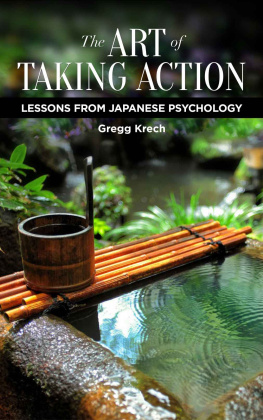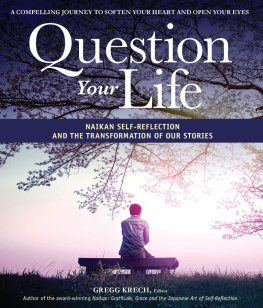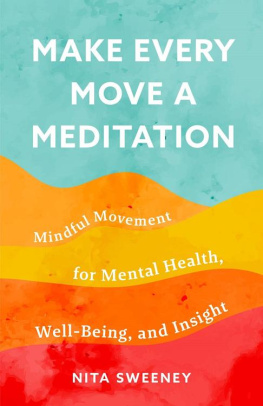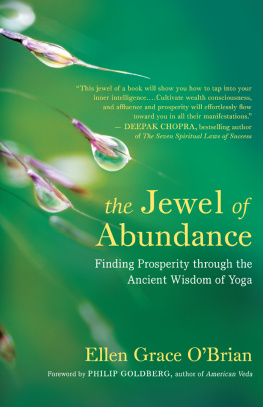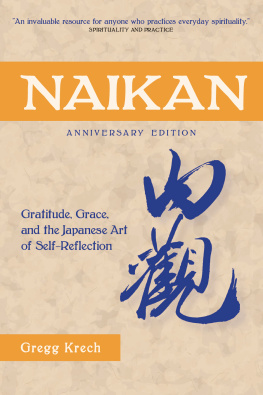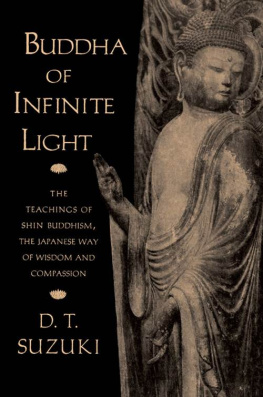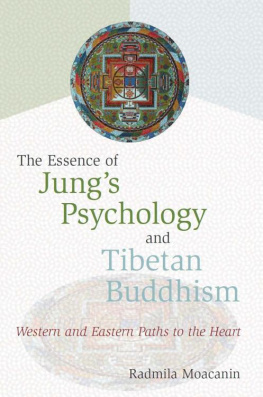Comments about The Art of Taking Action: Lessons from Japanese Psychology
In The Art of Taking Action , Gregg Krech has not just pointed out the importance of action to our lives, but formulated a system for deciding what truly should be done and then overcoming the obstacles that get in the way of following through. Happily, Krech not only has a grasp on what it takes to get going and keep going, he also has a gift for making Japanese wisdom both accessible and interesting to read.
Morris Sekiyo Sullivan, Buddhist Priest
The Art of Taking Action is the best book on developing habit/building character that I have ever read. The books insight is superb, with numerous examples of road blocks that people face when they try to make changes. An excellent bookintroducing Eastern Psychology to the West in a very practical way.
Ying Studebaker, former Director of Wellness and Health Coaching, Ohio State Univ. Health Plan.
The Art of Taking Action is an elegant approach to helping individuals deal with the dysfunctional relationships that lay at the root of many psychiatric problems. It offers a concise and practical approach to facilitating compassionate living even in the depths of despair .
Robert Strayhan, M.D.
The Art of Taking Action is a door way into living a life of accomplishment and satisfaction that leaves no one out. A cookbook for lifeproviding guidance and recipes that will nourish you and those around you. It addresses the kinds of challenges we all face in cooking our life, and is the best book of its kind that Ive ever encountered.
Ron Hogen Green, Zen teacher, MRO
In The Art of Taking Action , Gregg Krech has created a set of cables for jump starting projects of any size. And once the project is on the road, Krech uses wit and timeless spiritual wisdom to provide a map for the entire journey.
Victoria Register-Freeman, author, Love Stories from the Bible
The Art of Taking Action will help you do just that! If youre stuck in the muddle of your mind, this gem of a book will help you find your way out.
Susan Bourgerie, Loring Psychotherapy and Mindfulness Center
The Art of Taking Action is a practical and inspiring book on cultivating an active, purposeful life. In the world of daily responsibilities to family, work and community, its a useful guide to moving forward actively and gratefully and brings a lovely balance to contemplative practice.
Rev. William Masuda, Shin Buddhist Minister
The Art of Taking Action:
Lessons from Japanese Psychology
By Gregg Krech
Assistant Editor
Nancie S. Martin
Contributors
Trudy Boyle
Linda Anderson Krech
Jennifer Bucko Lamplough
Kate Manahan
Margaret McKenzie
Donella Meadows
Susan Page
Stephen Pressfield
Sharon Salzberg
Shinichi Suzuki
Jarno Virtanen
The Art
of
Taking Action:
Lessons from Japanese Psychology
By Gregg Krech
Published by the ToDo Institute
A 501(c)(3) not for profit organization
PO Box 50
Monkton, VT 05469
(802) 453-4440
www.todoinstitute.org
www.todoinstitutebooks.com
www.thirtythousanddays.org
Copyright 2014 by Gregg Krech
All Rights Reserved. No part of this book may be reproduced, stored in a retrieval system, or transmitted by any means mechanical, electronic, photographic (photocopying), recording, or otherwise, without prior written permission from the author.
The publisher would like to gratefully acknowledge those individuals who gave permission for their writing to appear in this book. Thank you.
Cover design: by Amanda Coyle. Cover image photo by Yasunari Nakamura.
Some of the material in this book previously appeared in Thirty Thousand Days: A Journal of Purposeful Living , a publication of the ToDo Institute. Used by permission. All rights reserved. Some of the essays from this book were originally published in A Concise Little Guide to Getting Things Done , also a publication of the ToDo Institute.
Also by Gregg Krech:
A Natural Approach to Mental Wellness
Naikan: Gratitude, Grace and the Japanese Art of Self-Reflection
A Finger Pointing to the Moon
Life is a Matter of Attention (CD-Audio)
ISBN: 978-0-9824273-9-2
Kindle Edition
www.artoftakingaction.com
Dedicated to my father
Ted A. Krech (1927-2014)
During my childhood my father would leave for work each morning between midnight and 1AM. He worked for a wholesale bakery in Chicago. He arrived at the bakery, loaded a 21 foot truck with more than 1,000 lbs. of bakery goods and then drove around the city delivering bread, bagels and dinner rolls to supermarkets, delis and restaurants. 1,000 lbs. on 1,000 lbs. off. He did this six days per week for more than forty years. For some of those years he worked a second job on Sundays to earn additional money for our family. He was, and still is, my personal model of effort and hard work. Thank you, Dad.
Is This Book for You?
There is a Buddhist story about four kinds of horses. The first horse is the best horse. He is responsive to the drivers will without even seeing the shadow of the whip. The second best horse will respond quickly to the sound of the drivers voice or, as soon as he sees the shadow of the whip. The third horse will run when he feels pain from the touch of the whip against his skin. And the fourth horse wont move until he feels the pain from the whip penetrate to the marrow of his bones. When it comes to taking action, which type of horse are you?
Realistically, youre probably a different horse in different situations. You may be an excellent horse when it comes to washing your dinner dishes, and you may be a horse that avoids writing, at any cost, the novel thats in your head. But most of us wish we were the excellent horse, no matter what situation we are faced with. Not only do we want to take the right action at the right time, but we want to do it mindfully, gratefully, competently and without being distracted.
Before you read any further, Id like to clearly state that if you function like the first horse, even most of the time, this book will offer you little benefit. Youll pick up a few tips and probably enjoy the ideas, but if youre already at the top of your game, then I offer you my sincere respect and admiration.
This book is written more for the other three horses and particularly for the last two who are in pain. Most of the time it takes pain to get them to move. Can you relate to that? If so, then this book can offer you something different. Its not just about doing more and procrastinating less. Its about your dreams, your passion, the risks you need to take and the opportunity to forget yourself and simply disappear into the moment as it unfolds. Its about less talk and more action. Its about less blaming and more appreciation. Its about less mindlessness and more presence.
So now you may be thinking that this book will help you become one of the best horses. Well not necessarily. Heres the paradox: its the fourth horse, the one who feels the most pain, who has the truest spirit. Its the fourth horse who has the biggest heart. The fourth horse has very little pride and arrogance and also has the most compassion for other horses who are struggling, because struggle is the thread of that horses daily existence.
You dont need to become the best horse or even the second best horse (after all, youre not really a horse at all). You just need to figure out how to work with your life with your circumstances, your feelings, your family members, your challenges, your dreams and your disappointments. You have to figure out what you need to do, when you need to do it, and how to do it to the best of your ability. Theres nobody whipping you from behind. Your life is in front of you, waiting for your next move.

